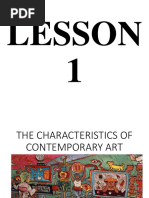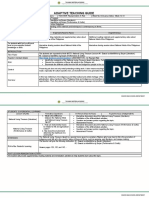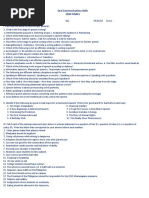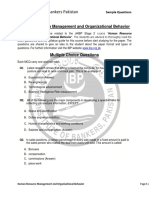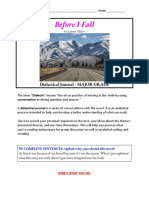Contemporary Arts in The Region (Philippines)
Contemporary Arts in The Region (Philippines)
Uploaded by
Rindelene Amora CaipangCopyright:
Available Formats
Contemporary Arts in The Region (Philippines)
Contemporary Arts in The Region (Philippines)
Uploaded by
Rindelene Amora CaipangOriginal Description:
Original Title
Copyright
Available Formats
Share this document
Did you find this document useful?
Is this content inappropriate?
Copyright:
Available Formats
Contemporary Arts in The Region (Philippines)
Contemporary Arts in The Region (Philippines)
Uploaded by
Rindelene Amora CaipangCopyright:
Available Formats
SH1721
LESSON TITLE: CONTEMPORARY ARTS IN THE PHILIPPINES 2
PRESENTATION OVERVIEW: LEARNING OUTCOMES:
Weeks 7-9, Sessions 19-27 Upon completing the lesson, students will be able to:
o Introduction 90 min LO12: compare traditional folk arts and contemporary
o Topic Presentation 275 min arts;
• Gawad sa Manlilikha ng Bayan 75 min LO13: explain the roles and identify the contribution of the
or National Living Treasures recipients of National Living Treasures Award to
Awards contemporary arts;
• The National Living Treasures 200 min LO14: evaluate the artworks based on the characteristics
o Homework/ Assignment 15 min of contemporary art;
o Generalization 50 min LO15: interpret and relate the significance of art forms
o Evaluation 15 min from the regions; and
o iLS/eLMS 5 min LO16: promote arts from the regions through a poem or
o 1st Periodical Examination 90 min a song that will be posted on a social media site.
(Session 26)
TOTAL 540 min
iLS/eLMS Activities (Sessions 21, 24 & 270 min
27)
MATERIALS/EQUIPMENT: TOPIC PREPARATION:
o Computer • Inform the class that they will be using their eLMS
o LCD projector account in the completion of the activity
o Files: 03 Contemporary Arts in the Philippines 2 requirements for the subject.
• 03 LCD Slides 1.ppsx • Remind the students that the handouts are available
• 03 Handout 1.pdf in their eLMS account.
• 03 Teaching Materials 1.pdf • Prepare the slides presentation, teaching materials,
• 03 Teaching Materials 2.pdf and worksheet needed for the discussion.
• 03 Teaching Materials 3.pdf • Prepare a quiz (03 Teacher-made Assessment 1)
• 03 Worksheet 1.pdf that will enable the students to demonstrate their
• 03 Worksheet 1 Answer Key.pdf knowledge in the topics covered in this lesson.
o Software requirements
• MS PowerPoint
TOPIC PRESENTATION:
I. Introduction
90 min Steps 1-5
Activity: Singing and playing folk songs
Learning Objective: LO12, LO14, LO15
Filipino Ingenuity
1. Present Slide 1 of 03 LCD Slides 1 for the outline of the topics to be discussed in this
lesson.
2. Instruct the students to form groups of six (6).
3. Discuss the mechanics of the activity on 03 Teaching Material 1.
4. Ask the following questions after the performance:
a. Were the materials used suited to the song?
b. Was there harmony in the singing of the groups?
03 Contemporary Arts in the Philippines 2 (Instructor’s Guide) *Property of STI
courseware.feedback@sti.edu Page 1 of 6
SH1721
5. Inform the students that the folk songs that they sang are already embedded in the
Filipino culture. Aside from folk songs, there are also different traditional folk arts that
have influenced or continuously influencing the contemporary arts in our country.
6. Discuss “Traditional Folk Arts” on Slide 2. Then, refer the students to Page 1-7 of 03
Handout 1 for further information.
7. Ask the following questions during or after the discussion:
a. Is the traditional folk arts incorporated in Philippine Contemporary Arts? Give
some instances.
b. Do the artworks have the characteristics of contemporary art that were discussed
previously?
c. Which among the traditional folk arts or practices are in danger of extinction?
d. How can you help in the promotion and preservation of traditional arts in the
country?
8. Inform the students following points:
a. The majority of the contemporary arts were shaped, influenced, and inspired by
traditional folk arts.
b. We can clearly see that the artworks that were done by the indigenous people
have the seven (7) characteristics of contemporary arts.
c. The traditional folk arts is one of the treasures of our nation. We must contribute
to the preservation and promotion of this art so that the future generation can still
witness the beauty of it.
Transition: “Proceed to the next activity.”
Institutional Outcomes: Character, Change Adept, Communicator, Critical Thinker
II. Gawad sa Manlilikha ng Bayan or National Living Treasures Awards
75 min Steps 1-4
Activity: Discussion
Learning Objective: LO13 and LO15
GAMABA
1. Inform the students that the National Commission for Culture and the Arts are giving
an award to recognize citizens that are engaged in the traditional art in our country.
2. Ask the following questions before proceeding to the discussion:
a. What is Gawad sa Manlilikha ng Bayan?
b. What are the categories of traditional folk arts that are recognized by the award?
c. What are the qualifications of a “Manlilikha ng Bayan?”
d. What are the honors and privileges of a “Manlilikha ng Bayan?”
3. Refer to the points below for the answers:
a. 03 Handout 1
• Page 7 – II. Gawad sa Manlilikha ng Bayan (GAMABA) or National Living
Treasures Awards
• Page 7 – A. Categories
• Page 7-8 – Criteria for selection
• Page 8 – Honors and Privileges
03 Contemporary Arts in the Philippines 2 (Instructor’s Guide) *Property of STI
courseware.feedback@sti.edu Page 2 of 6
SH1721
4. Continue to solicit answers. Then, discuss Slide 3-8 for clarification.
5. Divide the class into 13 groups for the activity next meeting. Discuss the instructions,
on Homework, Week 7.
Transition: “Proceed to the next activity.”
Institutional Outcomes: Character, Change Adept, Communicator, Critical Thinker
III. The National Living Treasures
200 min Steps 1-5
Activity: Group Report/Role Play
Learning Objective: LO12, LO13, and LO15
Ako’y Manlilikha ng Bayan!
1. Let each group present their report. Then, instruct those who are not yet reporting/ role-
playing to bring out their copy of 03 Worksheet 1.
2. Please bear in mind that each group has a maximum of 15 minutes (including fixing the
blocking, costume change, and setting up of props, if any) for the skit.
3. Remind the class to be respectful and attentive when a group is presenting.
4. As the facilitator, be mindful of the following aspects: completeness, accuracy,
character, and creativity.
5. Let the students cross-check their chart after the presentation. You may refer to 03
Worksheet 1 Answer Key to help you in this activity.
Transition: “Proceed to the next activity.”
Institutional Outcomes: Character, Change Adept, Communicator, Critical Thinker
HOMEWORK/ASSIGNMENT:
15 min Steps 1-7
Activity: Group Report/Role Play
Learning Objective: LO12, LO13, and LO15
Week 7
1. Show Slide 9-12.
03 Contemporary Arts in the Philippines 2 (Instructor’s Guide) *Property of STI
courseware.feedback@sti.edu Page 3 of 6
SH1721
As much as possible,
each group should have
at least one female and
one male member.
The students could use
the information in 03
Handout 1 or visit
http://ncca.gov.ph/about-
culture-and-arts/culture-
profile/gamaba/ for
further information.
2. Each group will present their report through portraying themselves as Manlilikha ng
Bayan or National Living Treasures and members of their respective communities.
3. Tell the students that as performers, they are highly encouraged to wear costumes and
bring props for the group presentation.
4. Call on a representative from each group to draw from the small container a strip of 03
Teaching Material 2. The number and the name on the strip of paper indicate the order
of presentation and National Living Treasure respectively.
5. During the activity, each group will be given 15 minutes to communicate the answers
to these guide questions:
a. What is the background of this National Living Treasure and his/her tribal or
ethnolinguistic group?
b. In his/her respective art category, what are the National Living Treasure’s
significant contributions to his/her community?
c. Why should you be proud of having this individual as a National Living Treasure?
d. What values/traits can your classmates learn from this National Living Treasure’s
artistic experiences?
e. How can you help in preserving and promoting the art of the National Living
Treasure that you presented? Suggest feasible ways on how to do it.
6. Inform the students that this will start commencing on the next meeting (Week 8,
Session 22).
7. Discuss the rubric that you will use in grading the students’ presentation in 03 Teaching
Materials 3.
Transition: “Proceed to the next activity.”
Institutional Outcomes: Character, Change Adept, Communicator, Critical Thinker
GENERALIZATION:
50 min Steps 1-3
Activity: Poem/Song Writing
Learning Objective: LO6 and LO11
Appreciating and Honoring the Artists
1. Instruct the students to compose a four-verse poem or song honoring and promoting
the great Philippine contemporary artists that have been discussed. They may write it
in whichever language they prefer.
2. As a part of promoting arts from the regions, the work should be posted to a social
media site.
3. Use the rubric below for checking their work.
CRITERIA PERFORMANCE INDICATORS POINTS
Content Provided pieces of evidence, supporting details, 20
03 Contemporary Arts in the Philippines 2 (Instructor’s Guide) *Property of STI
courseware.feedback@sti.edu Page 4 of 6
SH1721
and factual scenarios
Organization Expressed the points in clear and logical 10
of Ideas arrangement of ideas in the paragraph
Grammar Used correct grammar, punctuation, spelling, 10
and capitalization.
Creativity Used creativity and appropriate word choice in 10
expressing the message
Total 50
Transition: “Proceed to the next activity.”
Institutional Outcomes: Change Adept, Communicator, Critical Thinker
EVALUATION:
15 min Step 1
Activity: Quiz
Learning Objective: LO12, LO13, LO14, LO15, and LO16
Teacher-Made Quiz
1. Prepare quiz that will enable the students to demonstrate their knowledge on the
topics below:
a. Gawad sa Manlilikha ng Bayan or The National Living Treasures Awards
b. The National Living Treasures
Transition: “Proceed to the next activity.”
Institutional Outcomes: Communicator, Critical Thinker
iLS/eLMS:
5 min Weeks 7-9
1. Show Slide 13.
2. Task the students to log into their eLMS accounts and access module 03
Contemporary Arts in the Philippines 2. Then do the following activities:
a. Week 7: Finding a Treasure, Essay
b. Week 8: NLT Summary of Information, Dropbox
c. Week 9: Poster and Slogan Making, Dropbox
Institutional Outcomes: Character, Change Adept, Communicator, Critical Thinker
REFERENCES:
Anthropomorphic Pots. (2014). Retrieved on July 31, 2017 from
http://www.nationalmuseum.gov.ph/nationalmuseumbeta/Collections/Archaeo/Pots.html.
Manunggul Jar. (2014) Retrieved on July 31, 2016 from http://www.nationalmuseum.gov.ph/nationalmuseumbeta/Collections/Archaeo/Manunggul.html.
National Living Treasures Guidelines (2015). Retrieved from http://ncca.gov.ph/about-culture-and-arts/culture-profile/gamaba/national-living-treasures-
guidelines/ on July 25, 2017
Jacobson, J. (2015). 5 Architectural Secrets of the Badjao: 21st Century Sea People. Retrieved on July 26, 2017 from
http://www.archdaily.com/638523/5-architectural-secrets-of-the-badjao-21st-century-sea-people.
Panisan, W., Gazzingan, L., Samar, G., & Boongaling, C (2017). Contemporary Philippine Arts from the Regions.Malabon: Mutya Publishing House, Inc.
Piccio, B. (2016). Aklan’s Piña Fabric: The Queen of Philippine Textiles. Retrieved from
03 Contemporary Arts in the Philippines 2 (Instructor’s Guide) *Property of STI
courseware.feedback@sti.edu Page 5 of 6
SH1721
http://www.choosephilippines.com/specials/products/3943/aklans-pinya-cloth-jusi on July 27, 2017.
Perez, A. (2016). Philippine Contemporary Arts. Quezon City: Brilliant Creations Publishing Inc.
Ramirez, V. (2016). Contemporary Philippine Arts from the Regions. Quezon City: Vibal Group Inc.
Traditional Filipino Houses (2016). Retrieved on July 26, 2017 from http://wanderingbakya.com/traditional-filipino-houses/
Typology of Traditional Ivatan Culture and Architecture. (n.d.). Retrieved on July 26, 2017 from http://www.batanes.gov.ph/traditional-ivan-shelter/.
03 Contemporary Arts in the Philippines 2 (Instructor’s Guide) *Property of STI
courseware.feedback@sti.edu Page 6 of 6
You might also like
- English Pronunciation in Use Advanced Book With Answers and Audio Cds Frontmatter PDFDocument7 pagesEnglish Pronunciation in Use Advanced Book With Answers and Audio Cds Frontmatter PDFd-fbuser-18038696933% (21)
- Grade 12 Daily Lesson Plan Sta. Elena High School (SEHS) Grade 12 Philippine Contemporary Arts Third, S.Y. 2018-2019Document3 pagesGrade 12 Daily Lesson Plan Sta. Elena High School (SEHS) Grade 12 Philippine Contemporary Arts Third, S.Y. 2018-2019Noemi Del RosarioNo ratings yet
- Contemporary Week 5Document4 pagesContemporary Week 5Cow Cow CowNo ratings yet
- Demo ContempoDocument3 pagesDemo ContempoAudrey JanapinNo ratings yet
- I.Objectives: Contemporary Philippine Arts From The RegionDocument4 pagesI.Objectives: Contemporary Philippine Arts From The Regionlomboy elemschoolNo ratings yet
- MODULE 4 Conptemporary Philippine Arts From The RegionsDocument3 pagesMODULE 4 Conptemporary Philippine Arts From The RegionsFrance JavierNo ratings yet
- The National ArtistsDocument24 pagesThe National ArtistsKath Ventura100% (1)
- Week 2 Contemporary Arts DLLDocument5 pagesWeek 2 Contemporary Arts DLLMarites ManzanoNo ratings yet
- CONTEMPORARY WEEK 9 DoneDocument9 pagesCONTEMPORARY WEEK 9 DoneLady May CabreraNo ratings yet
- CAR DLL WK 1Document3 pagesCAR DLL WK 1joana torculasNo ratings yet
- Makiling Integrated School 11 Editha B. Robillos Cpar DECEMBER 2-6, 2019 2 Semester 1 QuarterDocument2 pagesMakiling Integrated School 11 Editha B. Robillos Cpar DECEMBER 2-6, 2019 2 Semester 1 QuarterEditha BalolongNo ratings yet
- Cpar ObservationDocument7 pagesCpar ObservationCrystal Renz M TibayanNo ratings yet
- CPAR Activity Sheets 3Document9 pagesCPAR Activity Sheets 3Brianna Nicole Mina MesticaNo ratings yet
- DLL-CPAR - October 3-6Document4 pagesDLL-CPAR - October 3-6SantiagoMateoGonzalesQuilal-lan100% (2)
- American Colonial PeriodDocument8 pagesAmerican Colonial PeriodYhale DominguezNo ratings yet
- I.Objectives: Grades 1 To 12 Daily Lesson Log School Grade Level Teacher Learning Area Teaching Dates QuarterDocument4 pagesI.Objectives: Grades 1 To 12 Daily Lesson Log School Grade Level Teacher Learning Area Teaching Dates Quarterlomboy elemschool100% (1)
- LP CparDocument2 pagesLP Cparshella conge100% (2)
- Contempo DLL July 1 Aug 4Document3 pagesContempo DLL July 1 Aug 4SteffiNo ratings yet
- Contemporary Philippine Arts of The Region Summative TestDocument1 pageContemporary Philippine Arts of The Region Summative TestKennie InocNo ratings yet
- DLL Pe 4Document4 pagesDLL Pe 4JayrLinsanganManuelNo ratings yet
- CPAR Pretest For 2nd SemDocument5 pagesCPAR Pretest For 2nd Semdominic condalorNo ratings yet
- Learning Plan-Con ArtsDocument17 pagesLearning Plan-Con Artsaileen alegadoNo ratings yet
- CPAR Module 3 Week 11 Lesson 3 Contemporary Art Production Artistic Skills and Techniques To Contemporary Art Creations 2Document4 pagesCPAR Module 3 Week 11 Lesson 3 Contemporary Art Production Artistic Skills and Techniques To Contemporary Art Creations 2Lhaika Maureen Casis100% (1)
- Contemporary Arts Q1M1M2Document8 pagesContemporary Arts Q1M1M2Aaliyah RebaldeNo ratings yet
- Contemporary Arts FormsDocument95 pagesContemporary Arts FormsAriane Mae LopezNo ratings yet
- 1st Lesson - Identify Various Contemporary Art FormsDocument25 pages1st Lesson - Identify Various Contemporary Art FormsJade JirehDelight Pile PanolinoNo ratings yet
- Cpar - Q2 Week6Document1 pageCpar - Q2 Week6Eduardo Jr Ocaña100% (1)
- Contemp WEEK 9Document11 pagesContemp WEEK 9Crystal Joy Aepole GalaponNo ratings yet
- Cpar DLL Week 1Document6 pagesCpar DLL Week 1Pontejos Princess Dianne G.No ratings yet
- 1contemporary Philippine Arts From The Regions PresentationDocument51 pages1contemporary Philippine Arts From The Regions PresentationMaricris Chavez79% (14)
- Cpar CotDocument19 pagesCpar CotCeloSakiNo ratings yet
- Cot 2 (01-24-2020)Document6 pagesCot 2 (01-24-2020)Mari ClaireNo ratings yet
- Department of EducationDocument2 pagesDepartment of EducationHershell ContaNo ratings yet
- I.Objectives: Contemporary Philippine Arts From The RegionDocument3 pagesI.Objectives: Contemporary Philippine Arts From The Regionlomboy elemschoolNo ratings yet
- Labrador Cot 2 LP PresentationDocument17 pagesLabrador Cot 2 LP Presentationkarell labradorNo ratings yet
- Contemporary-7 3Document4 pagesContemporary-7 3MlynNo ratings yet
- Lesson 1 - The Characteristic of ContemporaryDocument26 pagesLesson 1 - The Characteristic of ContemporaryMILDRED RODRIGUEZ100% (1)
- 3rd WeekDocument3 pages3rd WeekMaricar Narag Salva100% (1)
- Personality Fun Activities Games 748Document1 pagePersonality Fun Activities Games 748Hoshi MartinezNo ratings yet
- Contemporary-2 2Document3 pagesContemporary-2 2MlynNo ratings yet
- Contemporary Week8Document3 pagesContemporary Week8Cow Cow Cow100% (1)
- DLL 1 ContemporaryDocument2 pagesDLL 1 ContemporaryVivian ValerioNo ratings yet
- Summative Test in Contemporary Philippine Arts From The RegionsDocument2 pagesSummative Test in Contemporary Philippine Arts From The RegionsApril Ann Diwa AbadillaNo ratings yet
- DLL - CPAR Mod 3Document9 pagesDLL - CPAR Mod 3Coreen tabioloNo ratings yet
- Earth Sci DLL WEEK 5 FinalDocument4 pagesEarth Sci DLL WEEK 5 Finalmaricar100% (1)
- Department of Education: Republic of The PhilippinesDocument2 pagesDepartment of Education: Republic of The Philippinesferrer sheenamaeNo ratings yet
- DLL CPAR oCT 24-26, 2022Document3 pagesDLL CPAR oCT 24-26, 2022SantiagoMateoGonzalesQuilal-lanNo ratings yet
- Name: - Date: - Section: - Teacher: Sir Jeffrey de Belen 4 Quarterly Exam On Contemporary Philippine Arts From The Regions Test QuestionsDocument10 pagesName: - Date: - Section: - Teacher: Sir Jeffrey de Belen 4 Quarterly Exam On Contemporary Philippine Arts From The Regions Test QuestionsSirr JeffNo ratings yet
- Flexible Instructional Delivery Plan (FIDP)Document2 pagesFlexible Instructional Delivery Plan (FIDP)eco lubidNo ratings yet
- Weekly Learning Activity Sheet Solomon P. Lozada National High School Contemporary Philippine Arts From The Region 2 Quarter - Week 5Document7 pagesWeekly Learning Activity Sheet Solomon P. Lozada National High School Contemporary Philippine Arts From The Region 2 Quarter - Week 5RutchelNo ratings yet
- Artistic Skills and Techniques To Contemporary Art CreationsDocument25 pagesArtistic Skills and Techniques To Contemporary Art Creationsleanna tapangcoNo ratings yet
- Table of Specification 1 Semester/ 2 Quarterly Assessment Grade 12 Subject: Physical ScienceDocument5 pagesTable of Specification 1 Semester/ 2 Quarterly Assessment Grade 12 Subject: Physical ScienceArlance Sandra Marie MedinaNo ratings yet
- DLL Physical Sci.02 19 22 18Document4 pagesDLL Physical Sci.02 19 22 18Francis jroNo ratings yet
- Car DLL 1Document4 pagesCar DLL 1XierylleAngelicaNo ratings yet
- Week 1Document3 pagesWeek 1TOt's VinNo ratings yet
- CA - 6TH WeekDocument15 pagesCA - 6TH WeekLeah Jean Villegas100% (1)
- Cpar-Dll Apr-1-5-2019Document4 pagesCpar-Dll Apr-1-5-2019Glaitootxs Dela RosaNo ratings yet
- Lesson Plan in Contemporary Philippine A-1-CoDocument68 pagesLesson Plan in Contemporary Philippine A-1-CoCharrie Molinas Dela Peña100% (1)
- DLP Contemporary Arts COTDocument8 pagesDLP Contemporary Arts COTriza macasinag86% (7)
- Atg q1 Cpar WK 12-13 RzarDocument2 pagesAtg q1 Cpar WK 12-13 RzarReynard RedNo ratings yet
- Atg Q1 Cpar WK 12-13 RzarDocument2 pagesAtg Q1 Cpar WK 12-13 RzarReynard RedNo ratings yet
- Lesson PlanDocument9 pagesLesson PlanmatzuzilaNo ratings yet
- Disability Tax CreditDocument72 pagesDisability Tax CreditJose GonzalezNo ratings yet
- Output For WEEK 1 (Daily Lesson Plan)Document7 pagesOutput For WEEK 1 (Daily Lesson Plan)Liza DalisayNo ratings yet
- Speech Semi FinalsDocument2 pagesSpeech Semi FinalsCecille Hernando100% (2)
- Iot and Machine Learning-A Technological Combination For Smart ApplicationDocument4 pagesIot and Machine Learning-A Technological Combination For Smart ApplicationElmustafa Sayed Ali AhmedNo ratings yet
- DLL Mathematics 5 q1 w3Document9 pagesDLL Mathematics 5 q1 w3Maricelgcgjv Dela CuestaNo ratings yet
- Week 15Document6 pagesWeek 15SARATHA A/P RAMDASS MoeNo ratings yet
- ECSS M ST 80C (31july2008)Document42 pagesECSS M ST 80C (31july2008)cbungerothNo ratings yet
- Week 3 - Eapp (12-Humss M)Document3 pagesWeek 3 - Eapp (12-Humss M)Chelsea Iezer PinedaNo ratings yet
- Great LIFEDocument225 pagesGreat LIFEJohnerNo ratings yet
- Research Method Course PPT (3rd Years LaSu Students) 2012Document100 pagesResearch Method Course PPT (3rd Years LaSu Students) 2012Melkamu AmusheNo ratings yet
- Institute of Bankers Pakistan: Human Resource Management and Organizational BehaviorDocument3 pagesInstitute of Bankers Pakistan: Human Resource Management and Organizational BehaviorMuhammad KashifNo ratings yet
- Case Study On The TransformationDocument6 pagesCase Study On The TransformationPratik KhandualNo ratings yet
- Swadhin Kumar Das's Action Plan: CoachingDocument2 pagesSwadhin Kumar Das's Action Plan: CoachingSwadhin Kumar DasNo ratings yet
- I. Growth and Development: Nature or Nurture?Document7 pagesI. Growth and Development: Nature or Nurture?rizzamae belenNo ratings yet
- NSTP Lesson 2Document29 pagesNSTP Lesson 2Alyssa Dela VegaNo ratings yet
- Being OrganizedDocument5 pagesBeing Organizedleyla azhdarovaNo ratings yet
- Sarah Before I Fall Dialectical Journal (H)Document14 pagesSarah Before I Fall Dialectical Journal (H)Anaria ManojNo ratings yet
- Edited Summary Monthly Reading Progress Tracking ReportDocument1 pageEdited Summary Monthly Reading Progress Tracking ReportLeah Carnate100% (1)
- Apen Conference ReportDocument4 pagesApen Conference ReportpaulNo ratings yet
- 8 WK LRC KS3 Post Results TemplateDocument20 pages8 WK LRC KS3 Post Results TemplateMaricon PatanaoNo ratings yet
- Group 3 - Consumer PPT Final PDFDocument44 pagesGroup 3 - Consumer PPT Final PDFMili SukhijaNo ratings yet
- Developmental Kindergarten Curriculum Guide 20l7-20l8Document5 pagesDevelopmental Kindergarten Curriculum Guide 20l7-20l8api-311641812No ratings yet
- Week 15 MathDocument10 pagesWeek 15 MathSabin TahirNo ratings yet
- HRM 310 Summer 2012Document10 pagesHRM 310 Summer 2012Dennis B100% (1)
- Lesson Exemplar in MATHEMATICS 11 Using The IDEA Instructional ProcessDocument6 pagesLesson Exemplar in MATHEMATICS 11 Using The IDEA Instructional Processflorabel hilarioNo ratings yet
- 4.the Scientific AttitudeDocument7 pages4.the Scientific Attitudelaode ihksan juarzanNo ratings yet
- 1-2 Leçon AsynchroniqueDocument4 pages1-2 Leçon AsynchroniqueDaisy DeveraNo ratings yet
- Developing A Customer Value-Based Theory of The Firm: Marketing in The 21St CenturyDocument6 pagesDeveloping A Customer Value-Based Theory of The Firm: Marketing in The 21St CenturyAlesa A To ZNo ratings yet




































